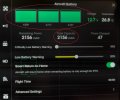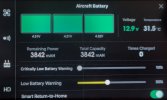It's my habit to be cautious, but I didn't pay enough attention to all the numbers.
Before takeoff I always do a checklist, which until a few days ago I thought was accurate and sufficient. As luck would have it, it's my habit to have the drone approach when the app indicates the battery is below 40%.
By the time the Mavic Pro was 100m away from me and 50m up, the battery was down to 30% and automatic RTH started. Since it was close and at low altitude, I interrupted RTH to take a couple of pictures. Suddenly, just 14 seconds later, the remaining battery power had plummeted to less than 10% and the drone began the landing procedure, without me being able to do anything.
My checklist also included checking the status of the batteries, but until yesterday, my eye was on the voltages to check that they were correct and look for any imbalances, while for the charge level I trusted the full battery image.
What I hadn't noticed, was the reduced mA capacity (only 2/3) at "full" battery. Battery that had charged without problems up to the 4th LED and then turned off, that has only 47 flights and that if I try to check the remaining life time (holding the button for 6 seconds) says that it is still between 90% and 100%.

Before takeoff I always do a checklist, which until a few days ago I thought was accurate and sufficient. As luck would have it, it's my habit to have the drone approach when the app indicates the battery is below 40%.
By the time the Mavic Pro was 100m away from me and 50m up, the battery was down to 30% and automatic RTH started. Since it was close and at low altitude, I interrupted RTH to take a couple of pictures. Suddenly, just 14 seconds later, the remaining battery power had plummeted to less than 10% and the drone began the landing procedure, without me being able to do anything.
My checklist also included checking the status of the batteries, but until yesterday, my eye was on the voltages to check that they were correct and look for any imbalances, while for the charge level I trusted the full battery image.
What I hadn't noticed, was the reduced mA capacity (only 2/3) at "full" battery. Battery that had charged without problems up to the 4th LED and then turned off, that has only 47 flights and that if I try to check the remaining life time (holding the button for 6 seconds) says that it is still between 90% and 100%.


Last edited:












